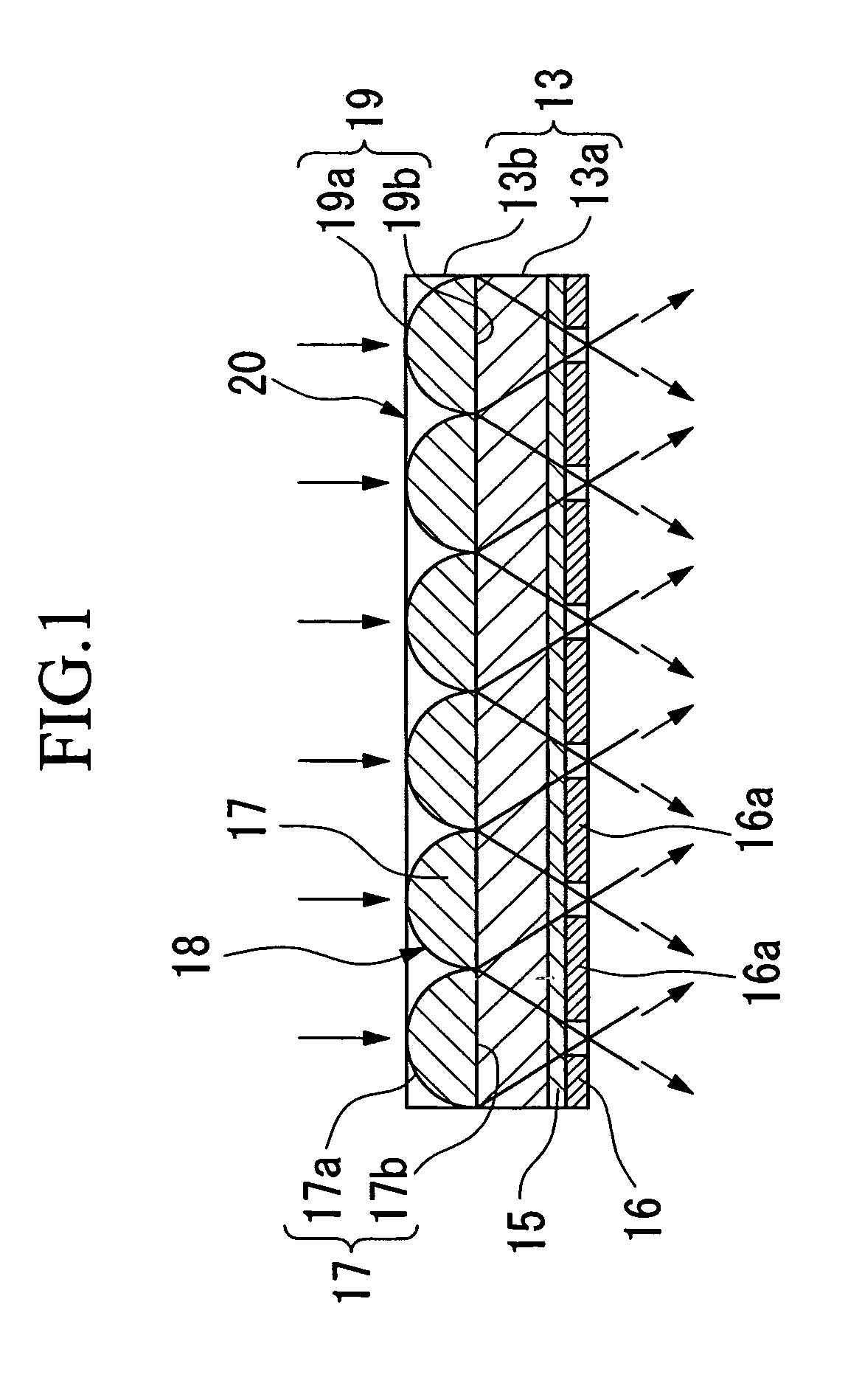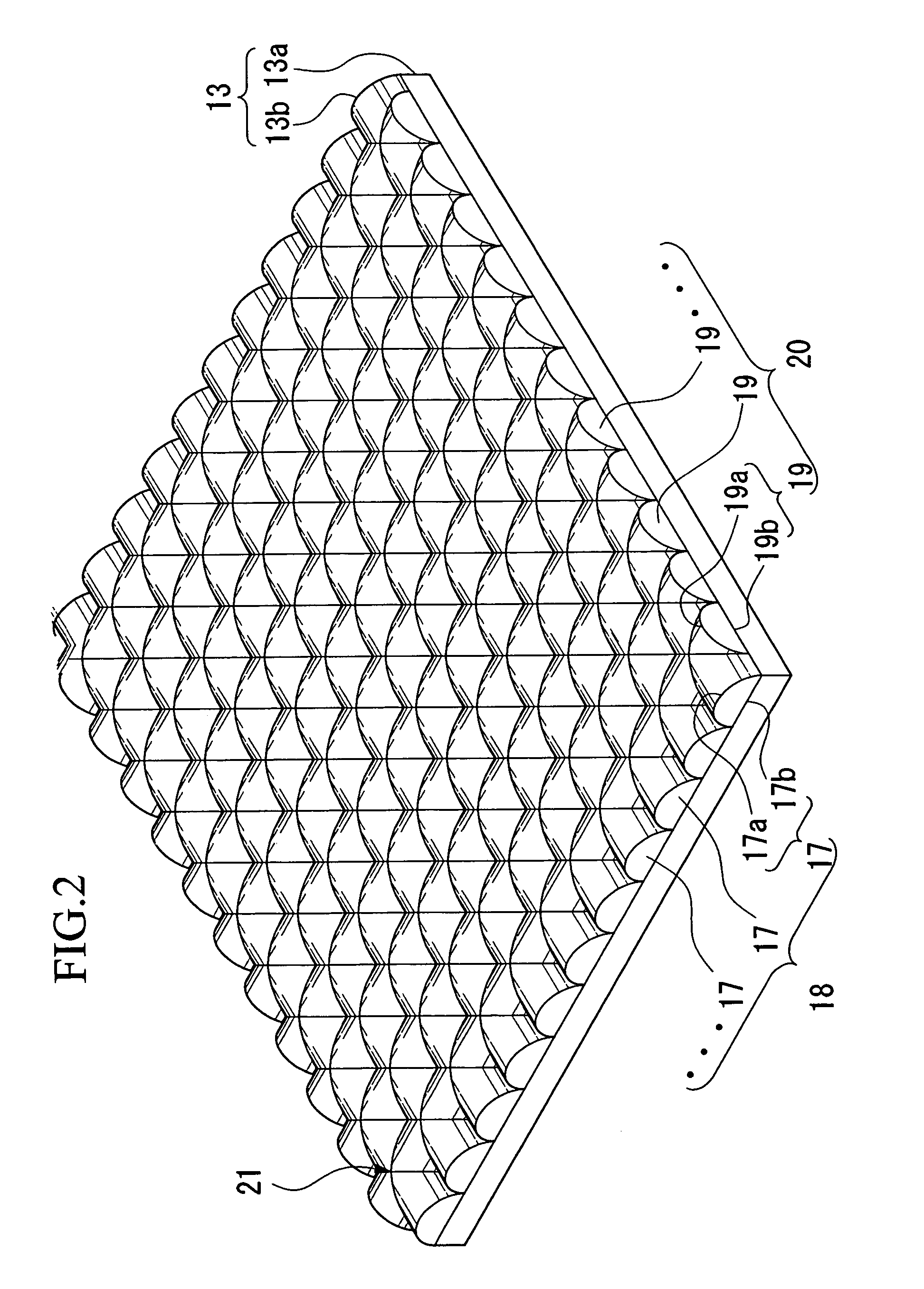Lens array sheet and transmission screen and rear projection type display
a technology of transmission screen and array sheet, which is applied in the field of projection display, can solve the problems of reduced gain, reduced s/n, high cost of material member and material member formation, etc., and achieve the effect of improving contrast and high shading ratio
- Summary
- Abstract
- Description
- Claims
- Application Information
AI Technical Summary
Benefits of technology
Problems solved by technology
Method used
Image
Examples
first embodiment
[0119]Hereinafter, a first example of the present invention is shown so as to clarify an effect of the present invention.
[0120]As explained above, the lens shapes for the lens array sheet shown in FIGS. 1 to 3 are designed. FIGS. 1 to 3 are drawn actually according to the designed shape.
[0121]In the present example, design parameters are determined as follows; thus, an experiment for proving the effect is performed.
(Design Parameters)
[0122](1) In the base member layer for the lens array layer, a material member is a Polyethylene terephthalate, and a thickness is 0.188 mm.[0123](2) In the lens layer for the lens array layer, a material member is an UV photosensitive resin. The lens is formed in an aspherical shape which is formed by adding a higher dimension with reference to a surface an oval surface which has 182 μm pitch.[0124](3) Cromarin (a registered trademark for a product of DUPON) film having 20 μm thickness is used for a photosensitive resin layer.
[0125]That is, a test piec...
second embodiment
[0128]Hereinafter, a detail of the second embodiment of the present invention is explained with reference to drawings as follows.
[0129]FIGS. 6 and 7 show an example or the lens array sheet according to the present invention. FIG. 6 is an isometric view for the lens array sheet. FIG. 7 is a cross section. FIG. 8 is a cross section for an important part of a prototype lens array sheet which is produced in an embodiment of the present invention which is explained later in an enlarged manner.
[0130]This lens array sheet 201 is formed by a base member layer 202 which is formed by a transparent material member, and a lens array layer 203 which is disposed on a surface of the base material layer 202. A feature of the present invention resides in a structure of the lens array layer 203.
[0131]In a structure of the above lens array layer 203, a first lens array 205 which is formed by disposing a plurality of cylindrical lenses 204 without intervals therebetween in parallel and a second lens ar...
third embodiment
[0157]Furthermore, a third embodiment of the present invention is explained with reference to drawings.
[0158]FIG. 12 is a view for explaining an example for a structure of a transparent projection screen which relates to a lens array sheet according to an example of the present invention.
[0159]In a structure for the projection screen which is shown in the above drawing, a fresnel lens sheet 390 in which a lens section 392 is disposed on a surface of a base board 391 near a light emitting section and a lens array sheet 380 in which an orthogonal lens section 382 is disposed on a surface (near light emitting section) of a light dispersing base board 382 which is formed by dispersing an optical dispersing agent (particle) is disposed such that mutual lens sections 392, 382 should face each other.
[0160]For such a transparent resin which is used for the base boards 392, 381, it is possible to use, for example, acrylic resin, polycarbonate resin, polyester resin, polyethylene resin, polyo...
PUM
 Login to View More
Login to View More Abstract
Description
Claims
Application Information
 Login to View More
Login to View More - R&D Engineer
- R&D Manager
- IP Professional
- Industry Leading Data Capabilities
- Powerful AI technology
- Patent DNA Extraction
Browse by: Latest US Patents, China's latest patents, Technical Efficacy Thesaurus, Application Domain, Technology Topic, Popular Technical Reports.
© 2024 PatSnap. All rights reserved.Legal|Privacy policy|Modern Slavery Act Transparency Statement|Sitemap|About US| Contact US: help@patsnap.com










